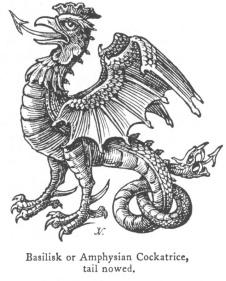
Fictitious and Symbolic Creatures in Art, by John Vinycomb, [1909], at sacred-texts.com

Fictitious and Symbolic Creatures in Art, by John Vinycomb, [1909], at sacred-texts.com
The amphysian cockatrice or basilisk in heraldry exactly resembles the cockatrice, but having an additional head (like that of a dragon) at the end of its tail instead of a barb or sting.
Amphisbœna, or Amphista, is a creature sometimes referred to by old writers as having the dragon's body and wings, the head of a serpent, and the tail ending in a like head. Bossewelle, in "Armorie of Honour," folio 63, enlarging upon this idea, describes "a prodigious serpente called Amphybene, for that he hath a double head, as though one mouth were too little to custe his venyme."
Earl Howe has for supporters two cockatrices (amphysian), wings elevated, the tails nowed, and ending in a serpent's head or, combed, wattled and legged gules.
Argent, a basilisk, wings endorsed, tail nowed, sable.—Langley, Rathorpe Hall, Yorks.
Basilisk, the king of serpents (Greek, Basileus, a king), so called from having on his head a mitre-shaped crest. Old writers give wonderful accounts of the death-dealing
 |
In allusion to its power of "looking any one dead on whom it fixed its eyes," Dryden makes Clytus say to Alexander, "Nay, frown not so; you cannot look me dead,"
King Henry, when he hears of the death of his
uncle Humphry, the good Duke of Gloucester, says to Suffolk:
[paragraph continues] Beaumont and Fletcher also speak of "the basilisk's death-dealing eye" in "The Woman Hater."
Its appearance was so dreadful, it was said, that if a mirror was placed so that it could see itself, it would instantly burst asunder with horror and fear.
In Christian Art it is the emblem of deadly sin and the spirit of evil. St. Basil the Great uses it as the type of a depraved woman.